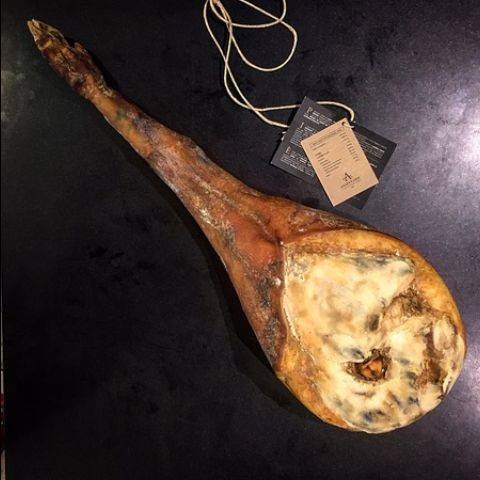ON OUR recent visit to Salumeria Agostino, at some point along the remote road taking us up into Sicily’s Nebrodi mountains, Sebastiano stopped the car. Here they are, he gestured. We’d finally come across a herd of his black swine, the Nero dei Nebrodi. Our first instinct was to get out the car: after all, we know pigs. But Sebastiano started and stared at us as if we were mad. What are you doing? he cried. You can’t get out the car - these pigs are dangerous.

That Rare Breed: A Landrace Pig
Nero Dei Nebrodi: The Black Swine Of Sicily
It is true: not all pigs are the same, although the 20th century farming narrative has tried to teach us otherwise. Today, most of the pigs that are reared for fresh meat and charcuterie are cross-bred Large Whites: a breed introduced mid-20th century to serve intensive, year-around production and to provide a uniform, minimal wastage product serving scalability and mass markets. It Is a breed bred for docility and although not necessarily an evil - many small Italian producers, including ours, make excellent salumi from these pigs, reared to domestic models and given the free space to grow slowly to a large size - its widespread adoption has endangered landrace breeds. Fragile and precocious, acutely sensitive to terroir, these rare breeds typically demand long maturation cycles and, at the end of it, produce a meat which goes against the market trend for lean. Sebastiano’s wife Luisa explains that their Nero dei Nebrodi take 2 years to mature to the small size of 130 kilos - of which 70% is fat. In commercial terms, that’s 70% wastage. But for Salumeria Agostino, that fat is why they’re raising these pigs in the first place.
The Nero dei Nebrodi has evolved over many centuries to have long legs for walking, a tapering head for foraging, and will typically be 70% in acorn-fed fat at time of slaughter.
THE NERO dei Nebrodi is their local heritage. Fossilised remains scattered over the Nebrodi mountains date this pig back to Sicily’s Greek-Carthage period (7th century) from where it has evolved over centuries with the poor and ragged terroir into a tall, long-legged, hard-hoofed pig that will walk over 30km a day for its food. It puts on fat as a shield to fight through the undergrowth and is identifiable by a tapering head and long snout for extreme foraging.
As Sebastiano tells us, in its temperament, and habits, it comes close to the wild boar, and should be approached with the same care: his spend their life running semi-wild through the mountain, which extends up through citrus groves, then oak and chestnut woods into stony, scrubby and forbidding forest. They’re housed only when the sows come to give birth - when they’re provided with shelter in the form of typical stone, gorse and fern strewn huts (zimme), which provide as natural as possible cover. In summer, when forage can be critically poor, Sebastiano will support his pigs’ diet with Sicilian cultivations, such as cicerchia, chickpeas and broadbeans - looking for markers such as the wild raspberry and the first fruits of the wild pear, which signal the start of Autumn when the pigs must fend for themselves. After all: the mountain is the secret to the Nebrodi’s flavour: the complexity of its meat and particularly its fat arrived at the most part spontaneously, by chance and by desire - a personal ratio of acorns, beechnuts, wild herbs, mediterranean buckthorn, berries and tubers particular to each pig. No one prosciutto will taste the same.
In the big-business world of prosciutto, even when we’re talking rare breeds, this level of autonomy is rare. Compare say, the Iberian pig and the Jamón Ibérico de Bellota that’s celebrated for its almost transparent flavour of acorns: achieved through a highly controlled diet whereby the pig is fed exclusively on acorns between October to February. Prior to this, its stomach will have been stretched by a diet of pumpkin to enable an uptake of around 10kg of acorns per day. There’s no doubt these pigs are treated like royalty, and that their prosciutto is extremely high welfare: but there is undeniably something designed about their flavour; the pigs as receptacles for an idea which is after all, not their own. The prosciutto Sebastiano makes from his Nebrodi is much more rustic, much less consistent in terms of a standard flavour profile and we’d argue, more expressive of a particular life lived in a particular terroir.
It is also, without that massive marketing infrastructure, and iconic name, much more fragile. Even within Sicily, the Black Swine’s identity dissolves beyond the hyper-local, reaching us in fact a decade or so back with all of the vagueness of a myth. If, even within its small native island it has disenfranchised from public knowledge, as the island increasingly converts its rich agricultural heritage to large scale production, what hope does it have of surviving?
The key is: international markets which can support the future of this breed, and its salumi. Which is why we’re delighted to be bringing over Sebastiano’s prosciutto - his bone-in ham - which will be appearing on our counter this month. We’ll also have his Salame, Salsiccia and Ricotta Salata.
Salumeria Agostino: A Small Family Business, 1000 Black Pigs
SALUMERIA AGOSTINO is a tight-knit family enterprise, with Sebastiano’s mother Pina - 65 years old, tiny, deft and spry - the norcina at the heart of it. Needless to say, female butchers are an extremely rare breed in themselves. Her cured meats, and fresh cuts, using exclusively the meat from the family’ herd are sold from the small butcher’s shop in Mirto. Sebastiano’s father, Vincenzo, also makes ricotta and caciocavallo from the sheep, goats and cows that roam their 70 hectares of land, the ricotta using whichever milk is plentiful, and in season.
PROSCIUTTO NERO DEI NEBRODI | aged for 2 years in old stone cellars, without saltpeter
SALAME | or, in local dialect, fellata: made with the prosciutto and coppa, seasoned with black pepper. Aged 3 months with saltpeter.
SALSICCIA | made with shoulder meat, seasoned with fennel pollen and seeds. Aged one month with saltpeter.
RICOTTA SALATA | made with either of raw sheep, goat or cow’s milk, or a mix. Drained for 48 hours then rubbed with salt and aged for one month.

